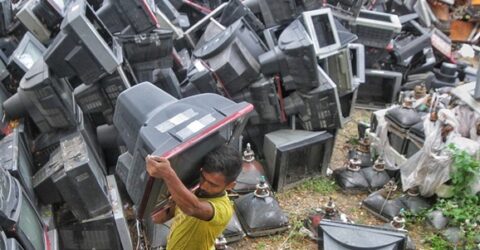What really happens to our electronic waste?
Electronic waste is generated in huge quantities each year, but we rarely consider what happens to it after we dispose of it.

An inevitable consequence of living in a technological age is that today’s technology swiftly gets superseded by tomorrow’s shinier and incrementally superior models.
Every year, smartphone manufacturers roll out handsets which are almost indistinguishable from their predecessors other than a higher model number and a slightly better camera.
Consumers then rush to trade in older (yet often perfectly functional) phones for these newer models.
Similar things happen – albeit less frequently – with tablets, laptops, televisions, games consoles and other media hardware.
Then there is the endless churn of headphones, charging cables, gadgets bought for a specific purpose which no longer applies, obsolete tech like DVD players and old iPods…
Little wonder the average UK household contains 25 electronic devices.
After that comes broken or failed equipment – overheating PCs, cracked smartphones, crackling speakers, devices that won’t power up any more, and so on.
Depending on your local council’s policies, electronic waste might be collected at the kerbside, dropped off at a recycling centre or require delegation to a local electronics firm.
Working media devices can sometimes be sold on auction websites, traded in as part of an upgrade, sold to specialist companies like Mazuma and CeX or even donated to charities.
A great deal of old electronic equipment festers in drawers, cupboards and attics across the UK. And even if we dispose of it, we rarely consider what happens to this electronic waste.
The truth is often surprising…
Going WEEE
Waste Electrical and Electronic Equipment, better known by the rather juvenile acronym WEEE, ranges from electronic tools to kitchen appliances and the items mentioned above.
Most consumers don’t know the likes of kettles, irons and smartphones can be recycled in reprocessing plants; even humdrum items often contain precious metals like gold.
Plastic can often be segregated by infrared light before being melted down and reformed into something else, while ferrous metals such as steel are extracted using magnets.
The Recycle Now website quotes the example of a hover mower’s copper motor being turned into anything from jewellery and coins to wire and winding mechanisms.
Circuit boards host precious metals such as platinum which could be repurposed in new devices, as can camera lenses, LCD screens, screws, speakers…
Unsurprisingly, many electrical retailers now accept unwanted consumer electronics.
What a waste
Despite their valuable components, not all electronic waste is treated with the respect it – or our planet – deserves.
An estimated 500,000 tonnes of domestic e-waste is illegally exported each year, literally outweighing the 479,000 tonnes which is properly recycled.
Our unwanted tat is dumped on countries with fewer resources or facilities to recycle or reuse it, fewer governmental policies on recycling and less consumer awareness of the dangers.
Volatile components in these items such as chromium and mercury pollute the environment and seriously damage human health, while much exported e-waste is crudely incinerated.
The environmental consequences of this are obvious and catastrophic in equal measure.
There are 350 million tonnes of unrecycled e-waste worldwide, comprising 70 per cent of the planet’s toxic waste.
Much of this originates from waste disposal or collection firms who promise to ethically dispose of collected items before doing nothing of the sort.
Consumers also contribute by discarding e-waste in non-recyclable bins, fly-tipping it at the roadside or dumping it at recycling centres lacking the capabilities to dispose of such items.
In landfill, electronic waste can generate methane gas which accelerates global warning, with other components polluting the soil and potentially poisoning entire local ecosystems.
Since the UK needs to improve on its dismal 31 per cent e-waste recycling rate, we all need to play a part in finding accredited and regulated homes for our electronic waste in future.
That means checking how to dispose of certain items before doing so in accordance with the manufacturer instructions.
It means extending the lifespan of electronic devices by repairing rather than replacing them, reducing how frequently we trade in working equipment, and treating older electronics carefully.
Above all, it means acknowledging that just because something leaves our home, it hasn’t left the planet…






